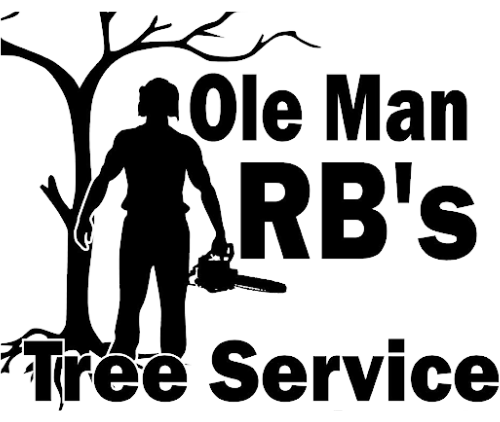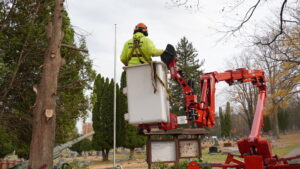
Trees add beauty, shade, and character to your property, but when they start to weaken, they can quickly turn from an asset into a hazard. Many Michigan homeowners don’t realize the warning signs of a failing tree until it’s too late, leading to property damage, injury, or costly emergency removals after a storm.
The truth is, trees rarely fall “without warning.” They almost always show visible signs of distress long before becoming dangerous. Knowing what to look for can help you act early and save yourself from a major headache (and bill) later on.
Here are five clear signs your tree might need to be removed before it becomes a serious risk.
The Tree Is Leaning More Than Usual
A slight lean isn’t necessarily a problem; many trees grow that way naturally. But if your tree is leaning suddenly, or the angle is becoming more pronounced, it’s a red flag.
A sudden lean can mean that the tree’s root system is compromised or that the soil around it has shifted, especially after Michigan’s heavy rains or freeze-thaw cycles. You might even notice raised soil or exposed roots on the side opposite the lean.
👉 Why it matters:
Once a tree’s root structure fails, it loses its stability. A strong wind or snow load can easily topple it, posing a serious risk to your home, car, or anyone nearby.
What to do:
If your tree starts leaning noticeably, contact a licensed tree removal professional right away. They can determine whether it can be stabilized or if full removal is the safest option.
You Notice Cracks, Cavities, or Decay in the Trunk
The trunk is your tree’s support system. When it starts showing signs of internal decay, the entire structure is at risk.
Look for:
- Deep vertical cracks or splits in the bark
- Large cavities or hollow areas
- Fungal growth (such as mushrooms) on the trunk or base
- Missing bark or soft, spongy wood
These are often indicators of internal rot, which weakens the tree from the inside out. Even if the canopy still has green leaves, a decaying trunk can’t support the weight of the branches for long.
👉 Why it matters:
A structurally weakened trunk can cause the tree to break or fall unexpectedly, especially during storms or high winds, a common occurrence in Michigan’s unpredictable weather.
What to do:
Schedule a professional tree health assessment. Certified arborists or licensed tree specialists can use tools to check for internal decay and recommend whether pruning, bracing, or removal is necessary.
The Tree Has Dead or Falling Branches
If you’re frequently picking up dead limbs after every storm or even on calm days, it’s a sign your tree is struggling.
Dead branches often mean the tree isn’t getting enough nutrients or water to certain areas. This can happen due to root damage, disease, or pest infestations.
You’ll also want to pay attention to where the dead branches are:
- Upper canopy: Indicates overall decline in health.
- One side only: May suggest root or trunk damage on that side.
👉 Why it matters:
Falling limbs are one of the most common causes of property damage from trees. Even a medium-sized branch can break windows, crush vehicles, or injure someone below.
What to do:
If more than 25% of your tree’s canopy appears dead or dying, it’s often safer and more cost-effective to remove the tree entirely rather than risk future limb failures.
Signs of Root Damage or Instability
Roots are the foundation of every tree, but since they’re underground, it’s easy to miss signs of trouble. Root damage can occur from nearby construction, soil compaction, driveway installations, or even excessive rainfall that leads to root rot.
Watch for these warning signs:
- Mushrooms or fungal growth at the base of the tree
- Exposed or decaying roots
- Sparse or yellowing leaves (especially at the crown)
- Soil heaving or cracks near the trunk
👉 Why it matters:
Once the root system is damaged, the tree loses its ability to absorb nutrients and maintain stability. In severe cases, it can fall with little warning, even if it looks healthy above ground.
What to do:
Avoid DIY digging or trenching near trees. If you suspect root damage, a professional inspection can determine whether the tree can recover or if removal is the only safe path forward.
The Tree Is Diseased or Infested with Pests
Michigan trees are no strangers to pests and diseases. From Emerald Ash Borer to Oak Wilt and Dutch Elm Disease, these threats can quickly turn a healthy-looking tree into a safety hazard.
Common signs of pest or disease problems include:
- Discolored, spotted, or wilting leaves
- Holes or tunnels in the bark
- Sawdust-like residue at the base (a sign of boring insects)
- Rapid canopy thinning
👉 Why it matters:
Infested or diseased trees not only weaken structurally but can also spread the issue to nearby healthy trees, putting your entire yard at risk.
What to do:
If you suspect disease or pests, call a professional tree service near you that’s familiar with local Michigan tree species. Early diagnosis can sometimes save the tree—but in many cases, safe removal prevents further damage to your property and landscape.
Don’t Wait Until It’s Too Late
It’s easy to overlook small warning signs until they become big problems. But proactive tree care can save you from the high costs and dangers of emergency removal after a storm.
If you’ve noticed any of these five red flags: leaning, trunk decay, dead branches, root issues, or pest damage, don’t wait for things to get worse. A quick professional inspection can determine whether your tree can be saved or if it’s time to remove it safely.
At Ole Man RB’s Tree Service, we specialize in safe, insured tree removal, stump grinding, and full property cleanup for Michigan homeowners. Our team uses top-grade equipment and expert techniques to protect your home, yard, and peace of mind.
📞 Contact us today to schedule your tree inspection or removal service before that tree becomes a real danger.


